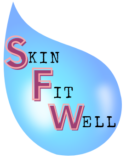You are not only dealing with textured skin from raised bumps, but also redness and irritation. It is important to find an acne treatment that targets both of these issues. Cue salicylic acid and azelaic acid. These are both treatments you can find over-the-counter that have many benefits.
Table of Contents
Salicylic Acid
What Is It?
Salicylic acid is a topical treatment used most commonly for acne, but is also used to treat melasma and photodamage (1). It is known as a desmolytic agent, in which it targets the desmosomes or “rivets” that hold skin cells together. In this way, salicylic acid works to peel the skin by promoting desquamation (shedding) of skin cells. This is a direct contribution to its comedolytic properties, in which it prevents the formation of comedones or blemishes (1). In addition, salicylic acid can increase the penetration of other ingredients.
Salicylic acid is a type of beta-hydroxy acid. This is a type of organic compound. It is lipid soluble, meaning that it can easily penetrate the epidermis and dissolve in skin lipids and sebum. This leads to a decrease in sebum secretion, thus improving acne (1). As mentioned above, salicylic acid targets desmosomes and the proteins that make up desmosomes, which loosens skin cells and this leads to exfoliation of the skin. In those suffering from acne, skin cells tend to pile up and hair follicles become clogged with sebum and cells. Since exfoliation removes these excess cells and sebum, this contributes to less clogged pores (1).
How Effective Is Salicylic Acid Treatment?
It is important to note that the effectiveness of salicylic acid is concentration-dependent. This means that a lower concentration of this ingredient will exert less therapeutic effects on the skin as opposed to a greater concentration (2). A study showed that twice daily application of pads containing salicylic acid promoted a decrease in inflammatory lesions (2). The use of salicylic acid has also been compared to glycolic acid, an alpha hydroxy acid. The results were similar although salicylic acid use resulted in less initial side effects (2).
In a study containing 38 males and females suffering from moderate acne, the use of salicylic acid decreased both non-inflammatory and inflammatory acne lesions over a period of 12 weeks (3). In comparison to benzoyl peroxide, there was no difference in its efficacy to reduce inflammatory lesions (3).
Azelaic Acid
What Is It?
Azelaic Acid is a powdered substance used in skin care products to treat skin conditions such as rosacea and acne. It has anti-inflammatory properties and is bactericidal against Propionibacterium acnes (now known as Cutibacterium acnes) (4). In addition, azelaic acid inhibits the action of tyrosinase, an enzyme that promotes pigmentation of the skin. It has also been shown to be anti-infective against Staphylococcus aureus bacteria (4). Azelaic acid reduces the amount of pro-inflammatory factors in the skin. This leads to a direct decrease in skin redness (4).
How Effective Is Azelaic Acid Treatment?
The use of azelaic acid gel in a study of over 300 patients showed a significant reduction in the amount of inflammatory lesions present (5). Also, use of this gel reduced skin redness in the participants. As mentioned earlier, azelaic acid is also great for those suffering from post-inflammatory hyperpigmentation and melasma. In a study using 20% azelaic acid cream, there was improvement in the skin condition of 65% of participants suffering from melasma (6).
The use of 20% azelaic acid has also been shown to be just as effective as a treatment for moderate inflammatory acne as benzoyl peroxide (7). Dating all the way back to 1989, azelaic acid has been extensively studied as a proven treatment in acne (8). It interferes with sebum production, has antimicrobial activity, and does not irritate the skin when used for long periods of time.
Which Treatment Is Right For You?
If you suffer from small comedones or blackheads, or even mild inflammatory acne, salicylic acid may be a good choice for you. Since it is a comedolytic agent, it helps to shed skin cells and prevent clogged pores. On the flip side, if you suffer primarily from red skin and moderate inflammatory acne, azelaic acid may be a better choice for you. It is a mainstay treatment in those suffering from red pustules due to rosacea, and has been shown to be effective in reducing inflammatory lesions without irritation in comparison to other topical treatments.
At the end of the day, acne treatments will be more or less effective depending on the type of skin condition you are experiencing. Look at the comparison chart below to see the benefits of both salicylic acid and azelaic acid. This way, you can make an informed decision regarding which treatment you might incorporate into your skin care routine.


